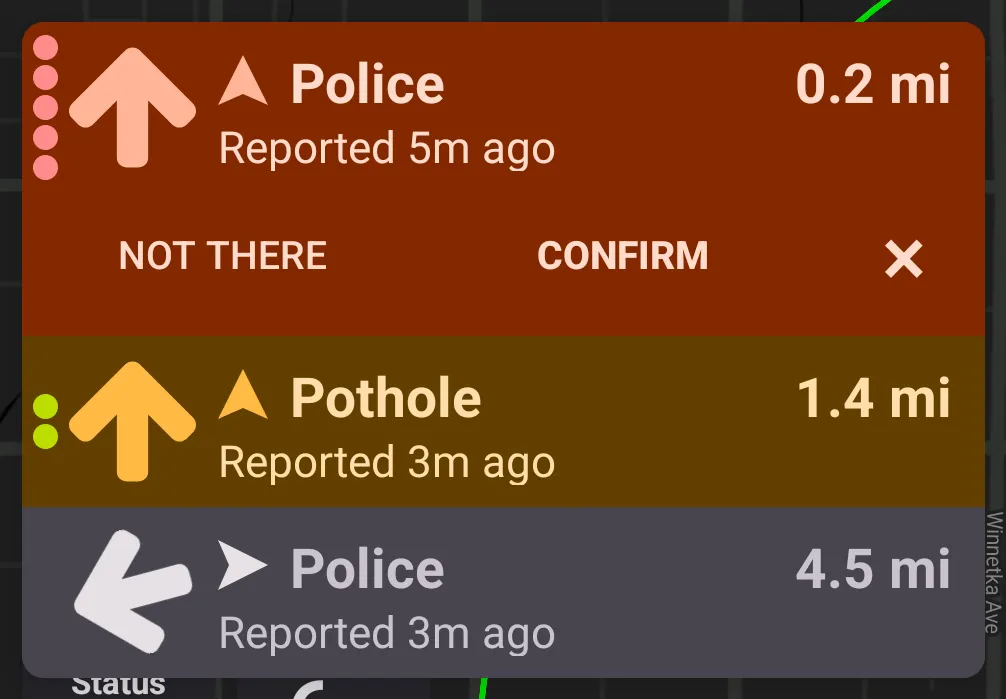Alerts Notifications
Configured in
Settings → Alerts Notifications.
Highway Radar has various means of notifications about approaching an alert. All configuration related to notifications is located in the "Alerts Notifications" section in settings. There are also shortcuts to the notification preferences of specific alerts types in related preferences sections (e.g., you can also get to aircraft notifications from the Aircraft preferences section).
Alert badge
Alert badges are displayed on top of the map in portrait layout, or on the left side in landscape layout. Alert badges show the bearing towards the alert with a big arrow, and a direction of the alert with a small arrow. You can see more information about meaning of different elements of the alert badge in the Screen Overview section.
For alert badges you can also configure the minimum alert severity, when the badge should appear. For alerts with a lower severity level, the badge won't be shown.
Map markers
Map markers are available for geo-referenced alerts, such as crowdsourced reports, aircraft, cameras, etc. Map markers aren't available for radar/laser alerts.
A map marker consists of the marker itself, and a label next to the marker. Their appearances are configured separately. For example, you can configure Highway Radar to show only markers for inactive alerts, and markers + labels for active alerts.
There are also two options for coloring the markers - the color may either depend on the alert type, or on the alert severity. Map label is always colored based on the alert type.
Beeper
A beeper is a continuous sound played when a specific condition exists. The possible conditions are current speed (see Activation Speed section for more details on this), and alert severity.
The beeper can be configured to quiet down automatically after several seconds after activation. When any new alert with the beeper appears while the beeper is quiet, the beeper is returned to the loud level (then quiets down again).
Beeper is supported for all alerts except non-speed cameras and hazards.
Conceptually the primary purpose of the beeper is to notify the driver about over-speed when an alert is presented. For example, when you're going faster than the current speed limit, and there is a nearby police report.
Bogey Tones
A bogey tone is similar to a beeper, but the bogey is a short sound played only once. Bogey doesn't repeat continuously. Bogey has activation conditions similar to beeper (activation speed, alert severity).
Bogey tone is helpful for quick notifications about new alerts – for example, for radar alerts. Another good use of bogey tone is reminding about the alert. For example, if police alerts are configured to activate at a long distance, it may be a good idea to play a bogey tone when approaching the police as a reminder about their presence.
Voice Announcements
Voice announcement can pronounce different properties of an alert. Those properties may include distance to the alert, reporting time, alert bearing and direction, aircraft registered owner, and others.
Voice is generated using a built-in TTS system of the phone (in most cases Google TTS). Voice announcements are only available in the English language.
The speech rate can be controlled using a corresponding preference in the "Sound" preferences.
Screen Flasher
Screen flasher briefly floods the applciation screen with a specific color when a certain alert becomes active or reaches some severity level. The color, speed, and number of flashes are configurable.
Camera flashlight
Same as screen flasher, but uses the built-in camera flashlight instead of flooding the phone screen. In real life mostly suitable only when driving at night.
Vibration
Same as camera flashlight, but vibrates the phoPne instead of flashing.
System notification
Allows pushing a system notification whenever an alert becomes active or reaches a certain severity level. The notification can also be intercepted by smart watch or automation software.





